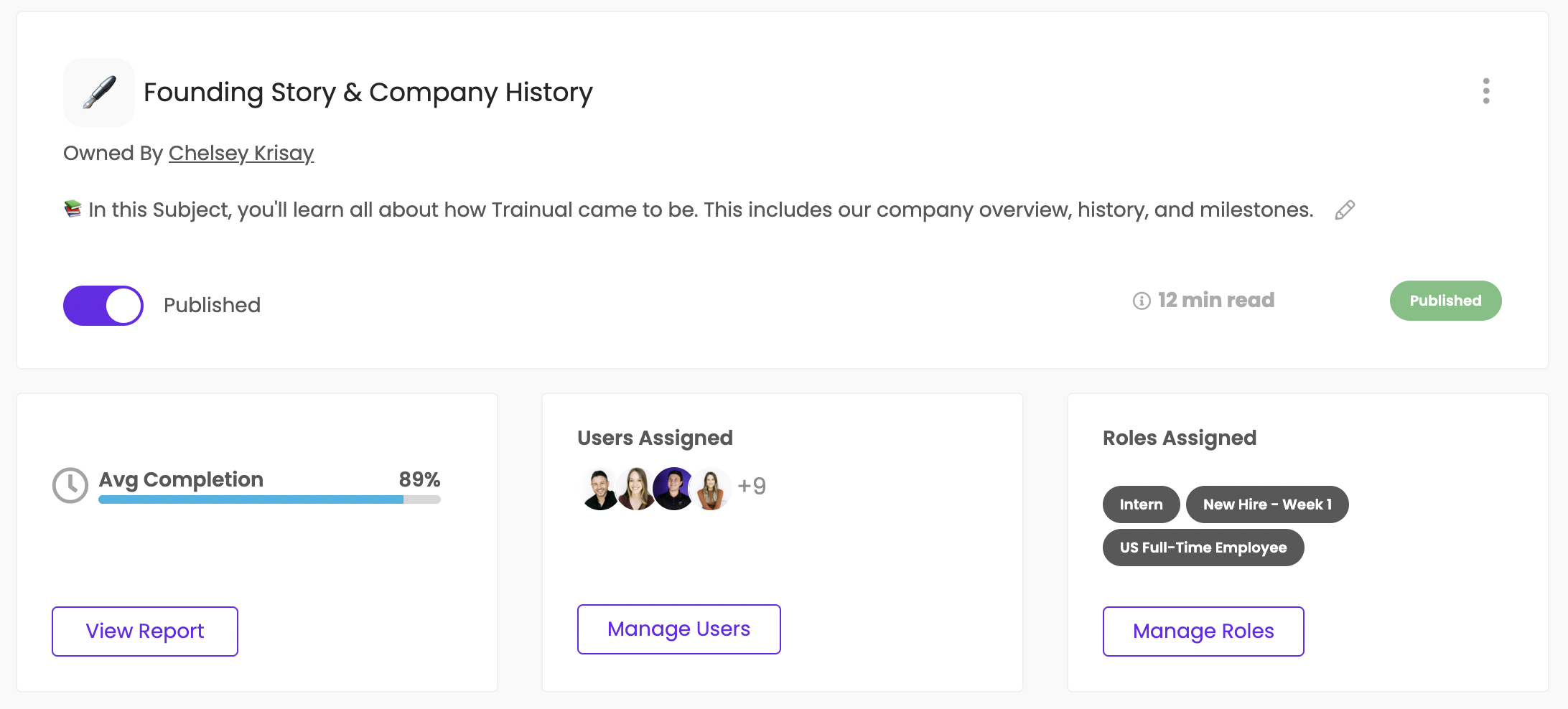
Articles
Creating a Company History Timeline That Gives New Hires Perspective
April 26, 2022

“I have great respect for the past. If you don’t know where you’ve come from, you don’t know where you’re going.” You can thank writer and civil rights activist Maya Angelou for that nugget of wisdom. And while she was referring to our personal and collective cultural history, the lesson here also applies to your business.
Like each of us, every company has a historical journey and a story. When you reflect on where your company started, where you are now, and where you plan to go, what do you see?
A clear growth trajectory? A shift in priorities? Maybe a few stumbles and setbacks along the way? No matter what your company’s story might be, understanding where your company started and the path it took to get where it is today can benefit a new hire.
If you want your new hires to understand the significance of their roles, it’s important that they see the big picture when it comes to your company’s journey. A company history timeline can give them the perspective they’ll need to thrive.
Creating a company history timeline can be an asset all on its own. Let’s take a closer look at the benefits of making a corporate history timeline, and the steps you’ll need to take to chronicle your past.
What to expect from this guide
In this guide, we’ll cover what a corporate history timeline is, why it matters, and how it can benefit your new hires.
We’ll also dive into what you’ll need to create a timeline, and the necessary steps to take when mapping out your history.
Finally, we’ll cover why it’s invaluable to make your history timeline available company-wide and to the public. Owning every success and hiccup of your company’s history adds value to your overall brand.
What is a company history timeline?
History can be the best teacher.
No matter how long ago you established your company, your mission and values have more than likely evolved to remain competitive. There’s no better way to document and showcase that growth than with a corporate history timeline.
According to Indeed.com, “A company history is a record of pivotal moments in your business from its origins to the present-day.”
With a timeline, you can record the who, what, when, where, and why of your company’s story. This includes who founded the company, their vision for it, the company’s values, and major milestones.
Why does my company history matter?
Your company history has benefits beyond just orienting a new hire — your corporate history is the foundation of your identity and overall brand.
Without it, you wouldn’t be where you are right now. Let’s take a closer look at some of the top reasons your company’s history matters:
1. It gives your new hire clarity around the present and future.
When a new hire walks through the door (or logs in, depending on how you conduct operations), they’ll hopefully know a bit about your company’s background from their research.
But since they weren’t there for the full ride, they can only step into the company’s present narrative and hope to remain a part of it well into the future.
By documenting your company’s history, you equip them with the context they need to understand why you operate the way you do. At the same time, they’ll get a much deeper understanding of the necessity of their role, which can boost their morale.
2. It allows you to embrace your triumphs and obstacles.
Chronicling your corporate history into a timeline is a good reminder of your company’s triumphs and obstacles.
Your company has a founding story. And, like every story, there are challenging moments. As a result, you adapted and continued forging your path.

A history timeline will allow your company to own every step of its journey — the good, the bad, and the ugly.
When you have the chance to reflect on your company’s successes, failures, vulnerabilities, and the people who made it all happen, that can send a positive signal to your new and established employees about what (and who) you value.
3. It boosts employee pride and fortifies company culture.
With a history timeline in place, your employees can see where you started, and they can compare that to where the company is now. And that journey is something to be proud of.
Putting your journey on display is a way to highlight your resilience, too. You might have team members who’ve been on the journey with you from the beginning. Company history can bring your company’s “why” back into the spotlight again.
Knowing that you all overcame a number of obstacles to get to where you are today can be inspiring to your new hires. And seeing that one day, they’ll play a part in that journey and can strengthen your company culture.
What you need to build a company history timeline
- The who: A list of the founders, their bios, vision, and goals.
- The what: These are the milestones and pivotal points of growth and setbacks.
- The where: Locations, types of operations, and how they influenced the mission over time.
- The when: The chronological beginning, middle, present, and future of the company.
- The why: Include your mission, values, and what you set out to do upon founding. Describe how that evolved and consider where you want to go.
To source these — as well as key historical company events and milestones — loop in your longest working employees; you might be surprised at what you discover.
How to build your company’s history timeline
Step 1: Pre-plan your narrative timeline basics.
You may have been there for every step of your company’s journey, but the truth is, our memories are faulty.
We may remember certain milestones better than others. Some might be more defining. Or, we could omit essential details from the past. Before you start constructing your company’s history timeline, you’ll need input from the people who’ve taken the journey with you. The goal is to create an accurate and comprehensive timeline of your company’s story and how you paved its path.
Step 2: Seek employee feedback.
Your company’s story isn’t based on a single experience. Think of it as a community or collective story that defines it. Everyone’s experience enriched the tapestry and helped define what the company is today.
That’s why it’s important to seek feedback from your employees. Here are some questions that can help tease out their part of the collective journey:
- What do you feel are our top three milestones?
- What were our defining moments?
- How has the company evolved from the beginning?
- How would you define our values when you arrived compared to what they are now?
Step 3: Include company goals, values, founder bios, and milestones in the company’s journey.
This step is the heart and soul of your company’s history timeline. Here, you’ll do your best to lay out the history from the beginning, but you’ll also want to stick close to pivotal moments.
Your vision, goals, and values have undoubtedly evolved since your company’s inception. Do your best to nail down your organization’s goals and values from those early years.
Include bios for your founding members as well. What did you all envision and hope to achieve? How did your dreams for the company evolve? What’s remained the same?
Here, it’s important to humanize the corporate structure. Give a glimpse into the minds and hearts of the people behind the curtain. That level of authenticity and relatability can speak volumes to a new hire.
Step 4: Avoid the urge to censor your history.
The thing about history is that it’s exactly that — history. On the surface, it might seem appealing to censor the obstacles you went through.
Maybe you don’t want your competitors to know every detail of your past. That’s understandable. You don’t want them keeping tabs on what they perceive as a vulnerability.
Likewise, the longer your company’s history, the more selective you’ll need to be about what you include and what you omit.
You don’t want your timeline to consume endless space on your website (or learning management system). You want to tell the story of your company and how it came to be, no matter which medium you use to show that journey. The question becomes, which details stay and which ones go without creating an alternative narrative?
Strike a balance
Resist the urge to censor your timeline. Sure, choosing what to include (and omit) is a form of censorship. You can’t possibly tell the company’s “full” story.
Aim for crafting the most accurate and authentic portrayal possible. For instance, talking about your past obstacles to new hires (or your competitors and the public, at large) is an act of authenticity. It will show that you acknowledge (or even embrace) where things might’ve gone astray.
What’s history (or a narrative journey) without obstacles? Answer: a cover up!
We’re human. Your company was founded by humans. You learned and grew from all of those roadblocks along the way. Be vulnerable and authentic when you create your history timeline by including some of those detours.
Step 5: Remember the visual aesthetic and graphics.
Populating your history timeline with clear milestones is more important than any heavy stylizing you might use to tell that story. You don’t need a graphic designer to gussy up your journey.
At the same time, you want the timeline to make sense and be appealing to your audience. Appealing doesn’t have to mean fancy. Instead, collect archival material that shows your company’s journey in photos, video clips, and other forms of media.
Reach out to your employees. See what they have on their own devices or social media. Consider how those captured moments better define your history.
Ready to document your company history?
Putting your company’s journey into a historical timeline is an asset for your employees — both new and established.
First impressions matter. Your new hire not only needs the resources necessary to perform their job successfully, but they also need a “big picture” view of the company, starting from the beginning. That view will give them the necessary context behind the creation of their role, in addition to many other valuable insights about the company’s path.
Getting your history down on a timeline and making it easily available doesn’t have to be a difficult process. Not only will it codify your journey, but it can help orient your new hires organically and authentically. Embracing and sharing your company’s roots is a necessary step toward blazing trails in the future.
Similar Blog Posts










